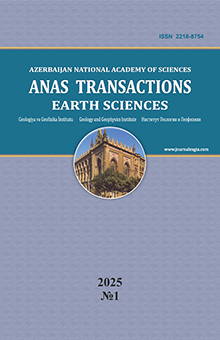Investigation of natural gas hydrate potential of the South Caspian Sea
Middle East Technical University, Ankara, Türkiye: mahmut@metu.edu.tr
Summary
Some unique characteristics of the Caspian Sea, especially the South Caspian Sea, such as low geothermal gradient, rapid sedimentation, a great number of mud volcanoes, suitable temperature and pressure conditions make it worth for exploration of gas hydrate potential. In this study, gas hydrate potential of the South Caspian Sea is determined within the targeted coordinates, 39°N - 50°E, 40°N - 50°E, 40°N - 52°E and 39°N - 52°E, which includes Absheron area and several mud volcanoes but excluding the parts shallower than 100 m water depth. The total area is subdivided into three categories, namely gas hydrate concentrated zone, gas hydrate bearing zone and around craters of mud volcanoes. The mean of accessible resource volume is estimated as 2.18´1012, 1.53´1014, 1.65´1010 Sm3 of gas for these three zones, respectively. The mean of total accessible resource volume of targeted areas is estimated as 1.75´1014 Sm3 of gas.
Keywords: Natural gas hydrates, the Caspian Sea, the South Caspian Sea, mud volcanoes, Monte Carlo method
REFERENCES
Buryakovsky L.A., Chilingar G.V., Aminzadeh F. Petroleum geology of the South Caspian Basin. [electronic resource]. Gulf Professional Pub. Boston, 2001.
CSMHYD. In Centre for Hydrate Research - Colorado School of Mines. Retrieved on December 27, 2017 from http://hydrates.mines.edu/CHR/Software.html
Diaconescu C.C., Knapp, J.H. Buried gas hydrates in the deepwater of the South Caspian Sea, Azerbaijan: Implications for geo-hazards. Energy Exploration & Exploitation, Vol. 18(4), 2000, pp. 385-400.
Fujii T., Saeki T., Kobayashi T., Inamori T., Hayashi M., Takano O., Takayama T., Kawasaki T., Nagakub, S., Nakamizu M.. Yokoi K. Resource assessment of methane hydrate in the eastern Nankai Trough, Japan. Offshore technology conference, 2008, DOI:10.2118/19311-MS.
Gerivani H., Gerivani B. Potential map of gas hydrate formation in Caspian Sea based on physicochemical stability evaluation of methane hydrate. Marine Georesources and Geotechnology, Vol. 35(1), 2015, pp. 136-142, DOI:10.1080/1064119X.2015.1118581.
Ginsburg G.D., Guseynov R.A., Dadashev A.A., Ivanova G.A., Kazantsev S.A., Soloviyev V.A., Mashirov Y.G. Gas hydrates of the southern Caspian. International Geology Review, Vol. 34(8), 1992, pp. 765-782.
Huseynov D.A., Guliyev I.S. Mud volcanic natural phenomena in the South Caspian Basin: geology, fluid dynamics, and environmental impact. Environmental Geology, Vol. 46(8), 2004, pp. 1012-1023.
Muradov C. Estimation of resources of gas in gas hydrate accumulations of Southern Caspian Sea. In: Abstract book of 7th International Conference ‘‘Gas in Marine Sediments’’, Nafta-Press. Baku, October 7–12, 2002, pp. 149-150.
Mustafayeva Z. Investigation of natural gas hydrate potential of the South Caspian Sea, M.Sc. Thesis, Middle East Technical University, Ankara, Türkiye, 2018.
@RISK. In Palisade. Retrieved on April 5, 2018 from http://www.palisade.com/risk/
DOI: 10.33677/ggianasconf20230300008
